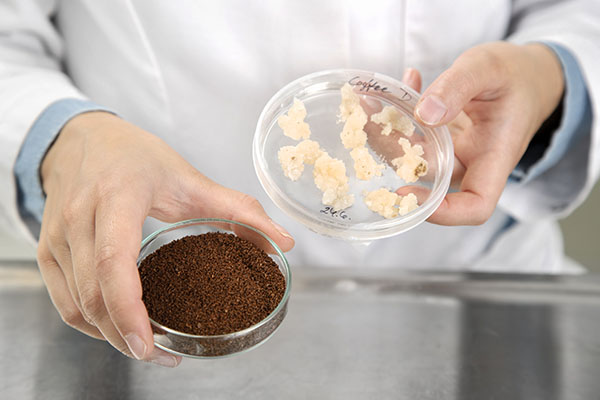In the future, will global demand for coffee outstrip supply? The International Coffee Organization thinks so, based on droughts in Central America, crop-destroying freezing weather in Brazil, and global climate change. In general, coffee is a very temperature- and drought-sensitive crop. Coffee is also susceptible to more than 350 known diseases. Add in the growing popularity of coffee—currently the second most consumed beverage worldwide (excluding water), after tea—and a potential coffee shortage looms. Because the coffee plant grows best high up in tropical mountain forests, cultivating more coffee plants through deforestation is not a sustainable option. To sustainably shore up the coffee supply, researchers at the Technical Research Center (VTT) in Finland have developed a process for producing coffee in the laboratory by growing the product in bioreactors. The ultimate question that the researchers had to answer was, “How does lab-grown coffee taste?” The short answer is that it tastes and smells just like natural coffee. See also: Coffee; Bioreactor; Deforestation; Extreme weather events; Global climate change; Sustainability

Cellular agriculture (also known as lab-grown food) is the process of producing agricultural products from cultured cells. For example, one of the most-reported applications of cellular agriculture in recent years is lab-grown animal protein. To produce lab-grown coffee, researchers in the laboratory first cultured cells derived from the leaves of the Arabica coffee plant (Coffea arabica). The coffee cells were then transferred to a bioreactor—a tank designed and operated to provide optimal conditions for growing cells—that produced cultured coffee cells. The cells (biomass) produced in the bioreactor were roasted, and then researchers brewed a coffee beverage using hot water. See also: Biochemical engineering; Biomass; Cell culture; Plant cell
Coffee roasting, which is designed to bring out the color and flavors in coffee, involves both science and art. In the roasting process, the coffee beans are heated to 150–200 degrees Celsius (300–400 degrees Fahrenheit), a temperature range at which the Maillard reaction of sugars and amines occurs, producing the aromas, flavors, and brown color of coffee. At about 190 degrees Celsius (370 degrees Fahrenheit), coffee’s natural sugars caramelize, adding to the roast's flavor. For a darker roast, heating continues to just below 230 degrees Celsius (450 degrees Fahrenheit), at which a pyrolysis reaction occurs, eliminating carbon dioxide (CO2) and producing a dark brown color and the bitter chocolatey flavor associated with dark-roasted coffee. The researchers roasted their coffee biomass in an oven rather than a roaster programmed to control time and temperature. Although the roasting process was not optimized, a variety of roasts were taste-tested. The researchers said that the coffee beverages tasted similar to “ordinary” coffee, with a darker roast being preferred. See also: Maillard reaction; Pyrolysis
Researchers do not envision that lab-grown coffee will compete with the best coffee beans in the world. However, they do think that lab-grown coffee could serve as a coffee substitute in applications such as low-grade, flavored, and possibly conventional (not sustainably or organically grown) coffee. According to the researchers, commercial lab-grown coffee could be available in about four years, as they still must scale the process for industrial production and obtain regulatory approval (required in the European Union and the United States). See also: Production engineering





